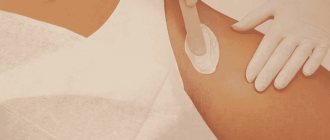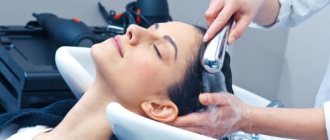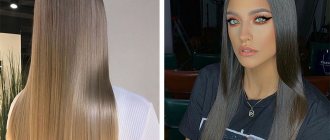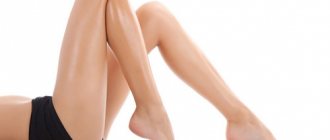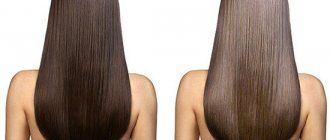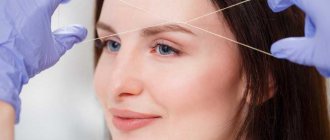Laser hair removal
There is no method yet that would guarantee that hair will never grow back. Much depends on the individual characteristics of the female body. Some have very little unwanted vegetation, it is thin and invisible. It is easier for such girls to make their legs smooth, if not forever, but for a long time. For others, the hair on their legs is thick, dense, and getting rid of it requires constant effort.
One of the most effective methods today is laser hair removal.
- The procedure is carried out with a special device that destroys hair follicles using a laser beam.
- The treated vegetation falls out and does not grow for a long time. If laser hair removal is done regularly at 2-3 month intervals, most hair will stop growing forever.
- After 2-3 years, new thin hairs will begin to emerge. They are easy to remove again in the beauty salon.
The process is slightly unpleasant, so everyone who wishes to apply an anesthetic cream or gel with lidocaine to the treated area.
The disadvantages of the procedure include its high cost and the fact that the laser does not work well on gray and light-colored hairs. The advantages are smooth legs for a long time and the absence of ingrown hairs, which cause many problems for women.
Let's get rid of it forever
Women all over the world are interested in how to remove leg hair forever. And modern cosmetology methods can help in solving this difficult problem, in particular, with the help of:
- Electrolysis.
- Photoepilation.
- Laser exposure.
- Elos hair removal.
Possible options for permanent leg hair removal should be discussed with an experienced specialist. He will suggest the method that will be most suitable in your situation.
Electrolysis
This method of removing body hair involves exposing the follicle to alternating current, as a result of which the latter is destroyed. Electric current is supplied using a very thin sterile needle; it is inserted one to five millimeters into the hair canal. The electrolysis procedure is successfully practiced in many beauty parlors and clinics, and it is also sometimes performed at home.
Pros of using electric current for hair removal:
- This procedure really allows you to get rid of unwanted vegetation forever.
- The method has a relatively low cost (when compared with photoepilation).
- Electrolysis can be practiced when removing hair of any type (various hardness and color) and on different parts of the body.
- The procedure does not cause ingrown hairs and cannot be complicated by infection.
Known disadvantages of electrolysis:
- Each hair requires separate processing, so the procedure takes a long time.
- Exposure to electric current causes significant discomfort and sometimes pain.
- Several procedures are required.
- After depilation, marks (wounds) remain on the skin, which take a long time to heal. Sometimes areas of irritation, minor burns and even atrophic scars can form on the body. Possible skin discoloration.
- When performing electrolysis on the legs, there is a risk of developing varicose veins.
- There are contraindications.
Today, scientists consider electrolysis to be the only method that guarantees the permanent elimination of unwanted hair. At the same time, photo or laser hair removal is considered only as a way to reduce the amount of hair.
Photoepilation
In photoepilation, hairs are removed by exposure to high-pulse light. Heat waves are absorbed by the hair pigment (melanin), which leads to blood clotting in the capillaries responsible for feeding the hair follicle. This, in turn, deprives the hair follicle of nutrition, and it dies or atrophies. Hair falls out and may not grow at all, but most often its natural development cycle is simply disrupted, the thickness of the hair shaft and the degree of pigmentation decrease (the hair becomes lighter).
Advantages of photoepilation:
- The procedure is non-contact. A special gel is applied to the skin, after which a device is brought to it that emits a beam of light.
- The skin is practically not damaged.
- There is no risk of infection.
- Speed (the duration of one session is no more than half an hour).
- Skin rejuvenation (heat waves activate collagen synthesis).
- The positive effect is noticeable after the first session (hairs fall out intensively, and those that grow back become sparser).
Despite the many positive aspects, this type of leg hair removal also has quite significant disadvantages:
- Photoepilation is a very expensive procedure.
- This method does not allow you to get rid of very light hairs, because they have practically no melanin.
- For smooth skin, you need to carry out three to seven photoepilation sessions. However, there is no guarantee that the hairs will not grow back.
- Sometimes photoepilation can be quite painful.
- The procedure has contraindications, in particular, it is not suitable for those with dark skin (after all, it contains a lot of melanin, which can cause burns).
Those who are interested in how to get rid of leg hair forever need to remember that photoepilation does not provide a lifetime guarantee. Most often, several courses of this procedure provide 100% smooth skin for only a couple of years, after which hairs begin to appear again, albeit thinner and sparse.
Laser removal
The laser hair removal technique is very similar in essence to photoepilation. It involves destroying hair follicles with laser radiation. Its energy is absorbed by the melanin of the hair, as a result of which it heats up and leads to the destruction of the growth zone of the hair, as well as those vessels that are responsible for feeding the follicle. After laser hair removal, hairs fall out along with dead roots.
Laser hair removal has, in principle, the same pros and cons as photoepilation. The main difference between these procedures is that the laser is not able to heat nearby tissues, therefore, the risk of burns is reduced to zero. In addition, photoepilation equipment is more cumbersome.
Some types of laser hair removal are suitable for those with dark skin. This method of getting rid of unwanted hair does not help eliminate light and gray hairs that do not contain melanin.
The easiest ways to remove hair on legs
A simple but not effective remedy is a sharp razor. The machine cuts the surface of the hair, and this makes it grow faster. Many women have to shave their legs every day, ensuring smooth skin at home.
- To prevent shaving from causing irritation and causing ingrown hairs, you need to thoroughly wash and steam your legs.
- Next, apply shaving cream and carefully run the blade in the direction of hair growth.
Advice
After the procedure, be sure to moisturize your skin. Apply a soothing cream or special cosmetic milk to it. Don't forget that a dull razor leads to skin injuries and the appearance of numerous ingrown hairs.
It is easy to remove leg hair at home using depilatory cream.
- It destroys the keratin in the hair structure, the hairs become soft and easy to remove with a spatula.
- The legs become smooth and soft, but the effect does not last long.
- To prevent hair from appearing for more than a week, after the procedure you need to apply a cream that stops the intensive growth of hairs.
If there are few hairs, but they are dark, it is better to lighten them with peroxide. Stir 1 tbsp. l. peroxide (6%) with 1 tbsp. l. liquid soap. Add 10 drops of ammonia. Mix and spread the mixture onto your leg hair. Leave for a quarter of an hour. If the vegetation does not lighten, repeat the procedure the next day.
how to treat legs after hair removal
How are you my queens???
You are so smart! You make me so happy :) Keep it up!!!
MAIN POST HERE
Today we will talk to you about foot care and pedicure.
The beauty of a woman has been glorified by poets for thousands of years, inspired artists, and simply drove men crazy. But if you want your feet not only to please the eye, but also to withstand with honor all the loads that fall on them, then you should not only actively admire them, but also carefully care for your feet at home. In my opinion, we do not take care of our feet as well as other parts of the body. This is completely the wrong approach. After all, not only our mood, but to some extent, the general state of health depends on the condition of our feet, so you should not neglect foot care. I want to offer some simple tips on how to care for your feet at home and how to make your feet beautiful and healthy. For normal foot care, it is enough to walk over your feet with a special hard washcloth, brush or cream-scrub during your daily shower to remove dead skin particles. After this, dry your feet, remembering to run a towel between your toes, dry them and massage them with nourishing foot cream. Then it’s good to sit and lie down for at least a quarter of an hour with your legs elevated, placing a pillow under your ankles - this will help relieve the load on your legs and relieve swelling. Foot care at home includes cleansing procedures. At least once a week, you should carry out thorough foot cleanings: after steaming your feet in hot or warm water, remove the softened stratum corneum with a pumice stone, a hard brush or a special foot grater. Not with a razor! After drying, massage with cream. After cleaning your feet, it is very good to rub a rich cream into the heels and put on cotton socks. If you do similar procedures every week, the skin on your feet and heels will be tender and soft, like a child's. When caring for your feet in the summer, it is especially pleasant to take foot baths. After all, in summer your feet get no less tired than in winter, and dust, heat, insect bites and sandal straps make them especially vulnerable. Sometimes, simply washing your feet frequently, accompanied by a light massage, can help prevent dry feet, small cracks and itching. Baths can be diversified by adding decoctions of medicinal herbs or essential oils - this is fun and useful. In addition, once you get a taste for foot care at home, you can “mix cocktails” from herbal infusions and aromatic oils. If time is catastrophically short, and my legs “hum” after a hard day, I personally do this - pour warm water into the bath, pour in more salt, and let my tired legs sit for 10-15 minutes. Fatigue and pain disappear instantly. Salt and water cleanse and tone the skin of the feet. It is very good to make foot baths with coarse sea salt, it will be beneficial for your feet and the body will replenish the lack of iodine. Here are the herbs with which you can also make foot baths: - mint, St. John's wort and nettle are refreshing; — pine extracts and oils, thyme and oak bark reduce sweating; — calendula and chamomile disinfect; - chamomile, linden blossom and honey help with swelling; — potato decoction softens the skin; - a bath with a couple of tablespoons of mustard helps at the onset of a cold. Taking care of your feet at home can also quickly relieve tired feet. Contrast baths are a great way to deal with fatigue: stock up on two basins, fill one with hot water (as much as you can tolerate), cold water in the other, and step from one basin to another until you get tired. In cosmetic stores you can buy various additives for foot baths, herbal mixtures, special milk or salt with additives. Typically, a foot bath is taken for five minutes, for cracks - ten, for excessive sweating of the feet - up to three minutes. The water should not be too hot. For some diseases, such as varicose veins, inflammatory processes, swelling, and sweating feet, it is better to take cooling baths. Cold foot baths constrict blood vessels, reduce pain and relieve inflammation.
The next step in foot care at home after taking a bath is foot masks. After taking a bath, you need to apply a foot mask. Cosmetic stores offer us a wide variety of creams and masks for feet. At the same time, it is quite possible to make effective masks without leaving the kitchen. If you apply a “homemade” mask for a long time (from 15 minutes), then you should put plastic bags on your feet over the mask and wrap them with a towel. Here are some tips for foot masks at home, which I myself have used: - I grind the celandine collected from the garden in a blender or meat grinder, cover the feet with the pulp, leave it on for half an hour or an hour (you can do it all night) - after this the skin softens, and the stratum corneum is simply removed hard washcloth; — lemon juice whitens and helps exfoliate horn cells — I rub my feet with a piece of lemon and leave for 10-15 minutes; — mayonnaise extremely softens the skin, which can be applied to the feet for an hour or more; — sour cream and curd masks soften the skin of the feet and whiten them, I apply them for an hour or more; - a paste of cabbage leaves, ground in a blender or meat grinder, applied for half an hour to an hour, helps with cracks on the feet; - a mask of warm mashed potatoes (it’s even better to make mashed potatoes from potato peelings) helps with calluses and corns, applied for half an hour or an hour. Do not forget also that for the full effect of baths and foot masks at home, you need to do them in courses of 2-3 months. Only in this case, foot care at home will give the desired result. Foot care at home also includes nail care. Toenails require the same careful care as fingernails. When trimming your toenails, do not cut off the corners, otherwise the nail will begin to grow into your toe. An ingrown toenail can also be caused by a foot defect or poorly fitting shoes. For ingrown nails (in the initial stage), it is recommended to use daily baths of chamomile: 6 tablespoons of flowers, pour 2 liters of boiling water, cover the container with a lid and leave for 1 hour. The strained infusion is heated again and the feet are kept in it until the water cools down. For the bath, it is recommended to use a decoction (boil for 10 minutes). The duration of the procedure is 15 minutes. After drying, carefully separate part of the nail from the tissue and place a small cotton swab moistened with iodine tincture. For pain, baths with potassium permanganate are also recommended. Foot care includes pedicure. How to do a pedicure correctly?
Pedicures should be done both in summer and winter, at least once a month.
For a pedicure at home we will need: *A bowl of warm water (with toilet soap, bath salts and/or essential oil)
*Pumice
* Foot scrub
* Sanding file
*Nail clippers and orange sticks
*Cuticle remover gel and cuticle oil *Finger spreader
*Cream and towel
Performing a pedicure:
First we apply the scrub!
Three heels with pumice stone intensively. Don't cut calluses! Now we apply the cuticle removing gel to the cuticles and you can put your feet in a warm foot bath: the water will relieve fatigue, moisturize dry skin, and soften the nails. To prepare a pedicure bath (if there is no special one), we need regular baking soda (1 teaspoon of soda per 1 liter of water) and a little liquid soap or shampoo). The bath time is 5 minutes. Wet your feet with a towel and gently clean under the nails with a stick. Then push back the cuticle. It should be cut only if it has grown greatly. Cut with pliers. At the same time, try to cut it in a continuous strip (if you cut it in pieces, burrs will form). Apply cuticle oil. If waves and tubercles are visible on the nails, then use a buff. To add shine to your nails, use the smooth surface of the buff. We trim our nails. Toenails should be trimmed straight. Don't cut them too short or round the corners to avoid ingrown toenails. File your nails, making the cut absolutely even. Polish the heels with a sanding file. Now it’s time for the most pleasant procedure - foot massage and application of cream. Wipe your nails with nail polish remover to remove beads of moisture and remaining cream. Apply a base coat to your nails, followed by two coats of polish and a sealer (gloss). Remove hairs from your fingers. Treat the instruments with any disinfectant. We must not forget that not only foot care at home is important, but also shoes. After all, the health of our feet largely depends on the right shoes.
When buying shoes, you should walk around the store a little to make sure that the shoes do not pinch or hang loose on your feet. It must be remembered that high heels or flat soles have a very negative effect on the foot. The optimal heel height, according to orthopedists, is 6.25 cm. Women who wear narrow shoes constantly experience discomfort, since the skin of the feet is subjected to friction and pressure, which is why calluses appear. To prevent the appearance of calluses, you should wear comfortable shoes, lubricate your feet with a softening cream as often as possible, and periodically get a pedicure. If you follow these foot care recommendations, you can remain irresistible in any situation. One of our main opponents in the struggle for beauty is laziness. When the mirror ceases to please us, and the clothes that suited you yesterday and made you beautiful, today only mercilessly reveal everything that you would like to hide, you only have yourself to blame. As the French say, only a lazy woman can have rough heels and unkempt legs. Many women begin to take care of themselves, believing in the healing value and immediate impact of the proposed measures. But most of them quit classes if they don’t see the expected results soon. Do not forget that visible results are not achieved instantly, take care of your feet at home regularly, do baths and masks in courses of 2-3 months, choose the right shoes, and your feet will be beautiful, healthy and attract admiring male gazes. SO, THE TASK:
1. We continue to follow our water regime, praise ourselves and be beautiful at home (write down the amount of water you drink and compliment yourself). 2. Perform our daily beauty rituals Morning: * wash our face * brush our teeth * gently massage our lips with a toothbrush
* all skin types - we do peeling and mask
* wash off the mask with water * tone the skin with an ice cube with green tea * restore PH with tonic or lotion * moisturize the face and neck with cream (along the massage lines) * check the shape of the eyebrows and adjust if necessary * apply cream/gel/mousse (who has what) on the skin of the eyelids with light patting movements, without stretching the skin, with ring fingers along the massage lines! * intimate hygiene * apply hand cream Evening : * makeup remover (cleanse the skin of cosmetics and dust during the day) - along massage lines! * brushing teeth * taking a shower (body scrub, hair removal) * making a hair mask * restoring PH with tonic or lotion (don’t forget about the neck!) * applying nourishing cream to the face and neck (along the massage lines) NO EYELID CREAM NEEDED! Don't forget to wear a headband to protect your hair. * apply balm to the lips * moisturize the skin with body milk (or someone else has cream/lotion/oil) * do neck exercises (10-15 minutes a day) * apply nourishing hand cream 3. DO A PEDICURE!
Dear girls! Another week of our Marathon is ending! This is the equator!)))
In order to move to the next “step”, you need to pass the “test”:
1. Get a manicure and pedicure.
2. Post your PHOTO report in a special post.
https://m.babyblog.ru/community/post/baby4833/1743723
Deadline: UNTIL 6:00 p.m. 06/8/2014!!!
From Monday 06/09/2014, only those who provide reports for ALL days and a PHOTO report of the competition in full will be participants in the ICG!!!
I kiss you, my queens!!! 
Ancient folk remedies
Some people believe that using folk methods can remove hair at home forever. Don't expect to achieve this. But it is quite possible to delay the growth process and stop it for a long time.
For the solution, prepare:
- iodine – 1.5 g;
- ethyl alcohol – 40 g;
- ammonia – 2 g;
- castor oil – 5 g.
Combine the components with each other and set aside for a couple of hours. When the product becomes light, soak cotton wool in it and apply generously to the skin. Wait until the composition dries, rinse it with warm water and rub the nourishing cream into your feet. Do the procedure regularly for 2 weeks. The hairs will fall out and will not appear for a long time.
In the old days, they used folk methods based on green walnuts and claimed that they helped get rid of hair forever. Collect 10 milk nuts, chop finely and add 1 tbsp. l. tar. Seal the mixture tightly in a glass jar and place it in the cellar for 2 weeks. Take out and systematically rub into the roots of unwanted hair until it falls out.
Depilation
So, let's start with the most popular:
Shaving
This is still the most popular method. Now there are alternatives, for example, a trimmer - here the blade does not come into contact with the skin, like a hair clipper. Now the nuances:
- How to do it right: the main thing here is a sharp blade and the use of shaving gel (cream, foam). The skin should be slightly moisturized, but not steamed. The most optimal effect is achieved by razors with several blades - the more, the better, and a “floating” head, which allows you to cut hair even at bends. After shaving, be sure to moisturize your skin. The most affordable option is olive oil with a couple of drops of lemon juice. And, by the way, it is better to shave your hair in the morning - the skin is more elastic at this time.
- Pros: fast, effective, painless and inexpensive - one replaceable cassette lasts on average 2 weeks to a month when shaving every other day. The service life of an electric razor is even longer. Razors are compact and can be taken on the go.
- Cons: firstly, shaving removes the top layer of skin, it becomes rough and dry, irritation and small cuts often appear, especially in sensitive bikini and armpit areas. Secondly, the hair itself seems coarser and darker, grows quickly, and the stubble has to be removed within a day.
Shaving is the best option for removing hair on your toes. The skin here is very sensitive to hair removal, but there is virtually no irritation.
Depilatory creams
Nowadays there is a huge selection of depilation products. The creams soften the hair, which is then removed with a special spatula.
- How to do it right: be sure to check your skin for sensitivity to the cream - you must first apply it to the elbow and wait. The hairs should be about 2-3 mm long, no less. Apply the cream to clean but dry skin, otherwise the cream will “slip” off the wet hairs. It is worth pre-treating the body with a scrub or washcloth for a longer-term result.
- Pros: also painless, the effect of depilation with cream lasts longer than with a razor - up to a week. And the growing stubble then becomes less prickly - the top of the hair becomes smoother.
- Cons: firstly, not all hair is removed at the root, and coarse hairs (like in the bikini area) may not be removed by the cream. Secondly, one package is enough for 2 times if applied only to the legs, and the price varies from 70 to 1000 rubles. Razors are cheaper. And, most importantly, depilatory creams are very chemical and are strictly prohibited for allergy sufferers, asthmatics, pregnant women and people with sensitive skin or skin diseases.
Regarding depilation, this is the main thing. Sometimes, to remove hair without a razor, they use a special pumice stone: they quickly rub it on the skin, and the hairs break off. But this method is very traumatic for the skin, and there is no proper smoothness after the procedure.
Waxing
To carry out the waxing procedure at home, you need to have hair of at least 4 mm. Take a hot shower, apply a scrub of coffee grounds to your skin and remove dead skin particles. You can remove hairs with hot and cold wax.
- In the first case, purchase the product at the pharmacy, heat it to a temperature of 60 °C and quickly apply it to your feet with a special spatula.
- Press on top with pre-prepared strips of fabric and wait a little.
- With a sharp movement, tear off the strip of wax against the growth of the hairs, picking it up by the edge of the fabric.
- Immediately disinfect the skin with an antiseptic and soothe problem areas.
- For this, herbal ice cubes are best suited to treat your feet. Finally, rub the cream into the skin.
Depilation is much easier with cold wax. You need to buy special strips and prepare your feet for the procedure. Each strip of wax must be slightly warmed in your hands and applied to the accumulation of vegetation. Wait a couple of minutes and tear off the strips along with the hairs.
Important!
After depilation, do not visit the beach for 2 days and after 3 days, be sure to do peeling. This will eliminate the appearance of ingrown hairs.
Simple home methods for leg depilation
Ice will cool your skin
- A suitable home remedy is to use ice cubes to wipe the skin immediately after removing the wax strips or before using the epilator.
- Essential oils of mint and eucalyptus, as well as some lotions and aftershave gels, have a cooling effect.
Have you noticed that at different times you perceive stimuli differently?
IMPORTANT: It has been proven that the pain threshold decreases due to stress and is associated with the level of the happiness hormone, serotonin. Therefore, it is better to do hair removal in a good mood and a relaxing atmosphere.
Hair removal with an epilator
With a small device it is easy to get rid of vegetation at home. It is better to pluck out leg hairs with an epilator when they are about 5 mm long. Then the wheel of the machine will easily grab them and tear them out.
Shaving with an epilator permanently solves the problem of unwanted hairs. The procedure will need to be repeated once every 1-2 weeks, and gradually the vegetation will become softer, thinner and less noticeable. The disadvantage of removing hair with an epilator is excessive pain, which not everyone can get used to. It all depends on individual sensitivity. After improper use of the epilator, many ingrown hairs occur, but this problem can be solved with proper care.
- Thoroughly cleanse the skin on your feet. Dry it with a towel and begin the procedure.
- To reduce pain, lightly stretch the skin with your free hand and select the minimum speed.
- Apply the epilator slowly against the hair growth. Take your time, otherwise the hairs will break off and the root will remain inside.
- Do not rub or squeeze the skin to avoid injuring it. Hold the hand with the epilator perpendicular to the skin.
By adhering to these small rules, you can reduce discomfort to a minimum.
Types of hair removal
Hair removal with wax is considered a fairly popular type of procedure. For this purpose, soft components are used that do not injure the skin.
In more sensitive areas, coarser varieties of the product are used.
Before the start of the event, the feet are cleaned with a scrub. It allows you to exfoliate the top layer of the epidermis from keratinized scales.
This measure promotes good adhesion of the wax film to the surface of the hair.
After this, the cleansed skin is treated with a special antiseptic. This completes the preparatory procedures.
The next step is to apply liquid wax.
A special spatula evenly distributes the product over the problem area. A thin paper strip is placed on top of the wax. After firmly fixing the paper base, you need to make a sharp movement against hair growth. At the end of hair removal, wax residues are removed with an antiseptic solution.
Sugaring is hair removal using sugar paste. The main advantage of this procedure is that it is hypoallergenic. It is suitable for the most sensitive skin. The application technology is somewhat similar to waxing.
Here, instead of a paper strip, a small lump of sugar paste is used. Hair removal occurs as it grows.
Solving the problem of ingrown hairs at home
Not a single girl is immune from ingrown hairs. With constant depilation with wax and other means, the skin becomes a little rougher. And when a new hair begins to sprout from the root, it may not break out, but remain inside the skin. This provokes inflammation, which causes painful, purulent pimples. Only careful hygiene and careful care can get rid of this phenomenon forever.
If you notice a few ingrown hairs on your legs, your best bet is to use aspirin. Grind the tablet into powder, dilute it with 1 tsp. water and lubricate the areas of inflammation. Keep it on for at least 30 minutes, this will make it easier for the drug to kill bacteria.
To get rid of ingrown hairs after depilation with wax or an epilator at home, try a folk remedy.
- Wet a terry towel with hot water and wrap it around the problem leg. Hold until the fabric cools down.
- Examine the steamed skin and you will notice small loops of hair.
- Gently pry them with disinfected tweezers and pull them out.
- Treat the area with peroxide and apply cream.
A variety of methods give every woman the opportunity to find a suitable way to remove leg hair as quickly, painlessly and, although not forever, but for a long time.
Skin care after hair removal
After epilation, you need to pay special attention to the skin of your legs.
In some cases, an allergic reaction may occur in the form of severe itching or irritation. A cold compress will help get rid of this manifestation.
Experienced experts recommend abstaining from solariums and hot water for a while.
To avoid dry skin, you need to lubricate your feet with a moisturizing cream or lotion with a soothing effect.
Contraindications
Leg hair removal is contraindicated in the presence of the following conditions:
- acute inflammatory and infectious processes of the skin of the legs - for all types of hair removal;
- malignant neoplasms and systemic diseases (the point concerns photo-, electro-, and laser hair removal);
- the presence of metal implants – for elos hair removal;
- pregnancy and lactation – for procedures using light, laser and other physical factors;
- epilepsy, diabetes, arterial hypertension - for elos, photo, laser.
